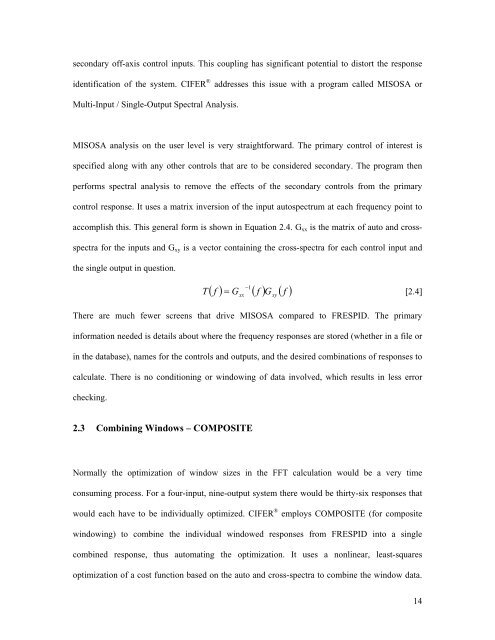CIFER®-MATLAB Interfaces: Development and ... - Cal Poly
CIFER®-MATLAB Interfaces: Development and ... - Cal Poly
CIFER®-MATLAB Interfaces: Development and ... - Cal Poly
You also want an ePaper? Increase the reach of your titles
YUMPU automatically turns print PDFs into web optimized ePapers that Google loves.
secondary off-axis control inputs. This coupling has significant potential to distort the response<br />
identification of the system. CIFER ® addresses this issue with a program called MISOSA or<br />
Multi-Input / Single-Output Spectral Analysis.<br />
MISOSA analysis on the user level is very straightforward. The primary control of interest is<br />
specified along with any other controls that are to be considered secondary. The program then<br />
performs spectral analysis to remove the effects of the secondary controls from the primary<br />
control response. It uses a matrix inversion of the input autospectrum at each frequency point to<br />
accomplish this. This general form is shown in Equation 2.4. G xx is the matrix of auto <strong>and</strong> crossspectra<br />
for the inputs <strong>and</strong> G xy is a vector containing the cross-spectra for each control input <strong>and</strong><br />
the single output in question.<br />
T<br />
−1<br />
( f ) G ( f ) G ( f )<br />
= [2.4]<br />
xx<br />
There are much fewer screens that drive MISOSA compared to FRESPID. The primary<br />
information needed is details about where the frequency responses are stored (whether in a file or<br />
in the database), names for the controls <strong>and</strong> outputs, <strong>and</strong> the desired combinations of responses to<br />
calculate. There is no conditioning or windowing of data involved, which results in less error<br />
checking.<br />
xy<br />
2.3 Combining Windows – COMPOSITE<br />
Normally the optimization of window sizes in the FFT calculation would be a very time<br />
consuming process. For a four-input, nine-output system there would be thirty-six responses that<br />
would each have to be individually optimized. CIFER ® employs COMPOSITE (for composite<br />
windowing) to combine the individual windowed responses from FRESPID into a single<br />
combined response, thus automating the optimization. It uses a nonlinear, least-squares<br />
optimization of a cost function based on the auto <strong>and</strong> cross-spectra to combine the window data.<br />
14













